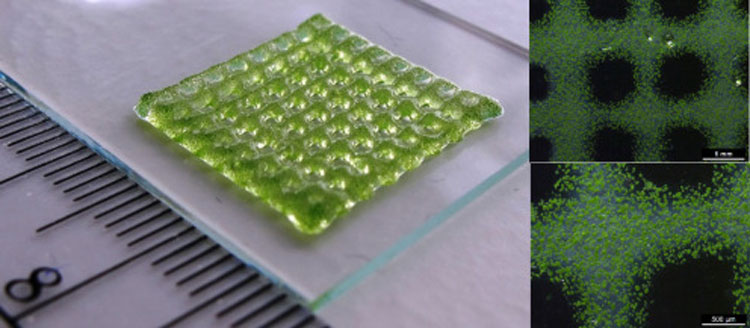Researchers from multiple institutions have developed a gel that uses oxygen sensitive nanoparticles for the printing of complex biofilms and tissue-like structures. The finding allows the researchers to detect oxygen content and visually indicate it using sensors. This new venture has potential applications in biophotonics, biomedicine and biochemistry.
The study demonstrates how these bio-inks could use sensor nanoparticles for monitoring algal photosynthesis and respiration as well as stem cell respiration in bio-printed structures with one or several cell types. Basically, the nanoparticles allow it to glow and the group can image them with a camera. While this may not seem like a big deal, it can be a godsend for studying cells on the micro-scale. Biologists could also monitor oxygen distribution without any heavy equipment.
Professor Michael Kühl at the Department of Biology, University of Copenhagen explains: “3D printing is a widespread technique for producing the object in plastic, metal and other abiotic materials. Likewise, living cells can be 3D printed in biocompatible gel materials (bio-inks) and such 3D bioprinting is a rapidly developing field, eg, in biomedical studies, where stem cells are cultivated in 3D printed constructs mimicking the complex structure of tissue and bones. Such attempts lack online monitoring of the metabolic activity of cells growing in bio-printed constructs; currently, such measurements largely rely on destructive sampling. We have developed a patent-pending solution to this problem.”
Developing Biogels
The group developed the bio-ink by inserting glowing oxygen sensitive nanoparticles into the print matrix. When blue light excites the nanoparticles, they emit red luminescent light in proportion to the local oxygen concentration. With more oxygen, there is far less red luminescence and vice versa.
Cameras can capture the distribution of red luminescence and thus oxygen across bio-printed living structures. The main benefit is in online, non-invasive monitoring of oxygen distribution and dynamics that researchers can map to draw correlations with the growth and distribution of cells in the constructs without the need for destructive types of sampling.
Prof Kühl states that “it is important that the addition of nanoparticles doesn’t change the mechanical properties of the bio-ink, e.g. to avoid cell stress and death during the printing process. Furthermore, the nanoparticles should not inhibit or interfere with the cells.” Non-invasive forms of research are, after all, crucial to studying delicate forms of biology.
The research may even have further applications beyond the purely biological. It may be a great way of creating natural/non-electric luminescence in dark habitats or even rooms. It could be of great use in space, particularly with it’s ability to study oxygen levels without disturbing the samples. The research is still young and researchers are still experimenting with new forms.
Featured image courtesy of Anya Lode/TU Dresden, retrieved via Drug Target Review. The full study is available here.




